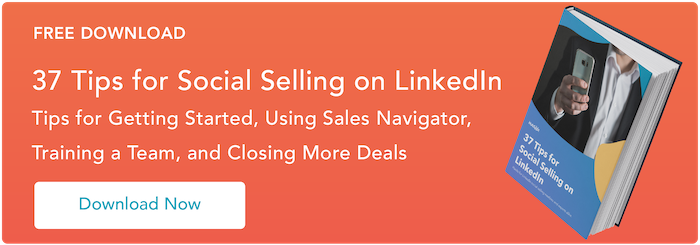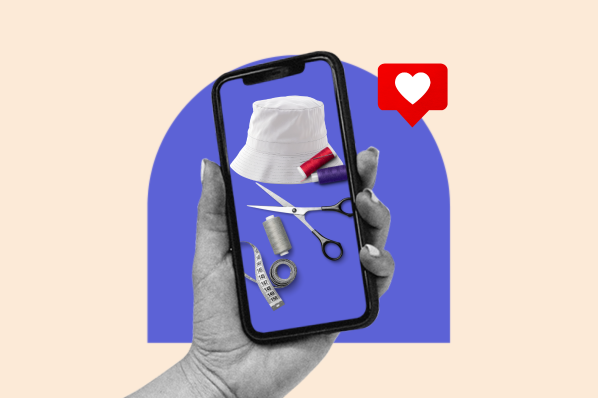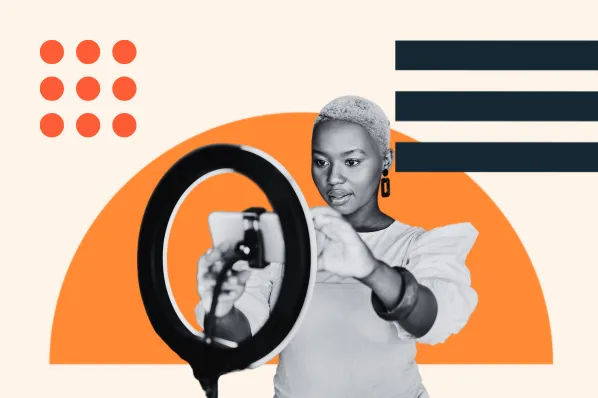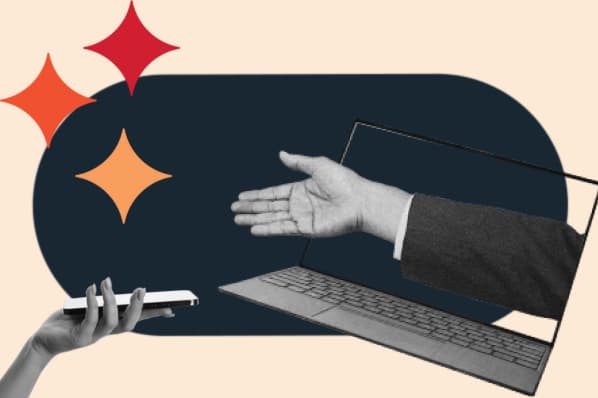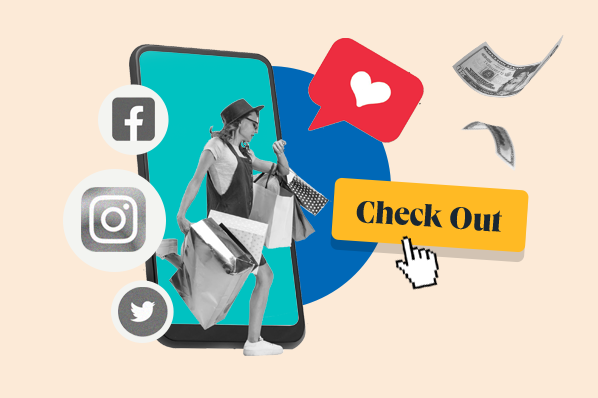LinkedIn isn’t the boring B2B platform that you might think it is. I know because I’ve been posting regularly on LinkedIn for two years.

I’ve now amassed over 27,000 followers. I credit LinkedIn for my writing opportunities, podcast appearances, qualified leads, top-tier clients, and business success.
I’m not the only one who rates LinkedIn for its return on investment (ROI). HubSpot surveyed social media marketers, and 92% rate LinkedIn as having high (43%) or average (49%) ROI.
Like everyone else, I started with a LinkedIn profile that no one saw and stuffy, boring, and unengaging posts.
Things got better when I saw LinkedIn as a vibrant social media platform with inspiring creators trying to connect with like-minded people. I started reading blogs and implementing LinkedIn tips that elevated my profile, connections, followers, and engagements.
In this article, I’m sharing my favorite tried and tested LinkedIn hacks in no particular order. Included are some not-to-be-missed tips by LinkedIn’s best creators.
If you implement all of these tips and tricks, I have no doubt you’ll make your LinkedIn a success, whatever your goals.
In this article:
- How does the LinkedIn algorithm work?
- How to think about LinkedIn
- LinkedIn Hacks to Optimize Your Profile
- LinkedIn Networking and Growth Tips
- LinkedIn Posting Hacks
- LinkedIn Hacks for Job Seekers
How does the LinkedIn algorithm work?
Before we get into the LinkedIn tips and tricks, let’s look at the algorithm briefly so you can see the why behind these LinkedIn recommendations.
Since LinkedIn doesn’t share its algorithm, I’m sharing my best understanding of the platform based on my experience and the experience of some of the greatest LinkedIn creators.
From what I’ve seen, below are some of the core algorithmic features:
1. Keywords.
2. Commenting.
3. Dwell time and post-engagements.
Keywords
Keywords are everywhere on LinkedIn: in your posts, your profile generally, in your heading, and even in your experience section. The section below will help you use keywords wisely so you can be found for searches that matter to you.
Commenting
From experience, commenting is a big factor on LinkedIn. Justin Welsh is a LinkedIn Guru with over 560,000 followers.
In his posts, he advocates for commenting and recommends users reply to comments on their posts and add 10 to 15 comments on other people’s posts.
Dwell Time and Post Engagements
A section of Welsh’s LinkedIn course discusses the role that dwell time plays in LinkedIn. Dwell time is a pause over a comment.
Post engagements such as clicking “read more,” reacting, sharing, and commenting tell the algorithm that a post is engaging. Engaging posts are rewarded with more visibility on user feeds.
HubSpot uses the information you provide to us to contact you about our relevant content, products, and services. HubSpot will share the information you provide to us with the following partners, who will use your information for similar purposes: Surfe. You can unsubscribe from communications from HubSpot at any time. For more information, check out HubSpot's Privacy Policy. To unsubscribe from Surfe's communications, see Surfe's Privacy Policy.
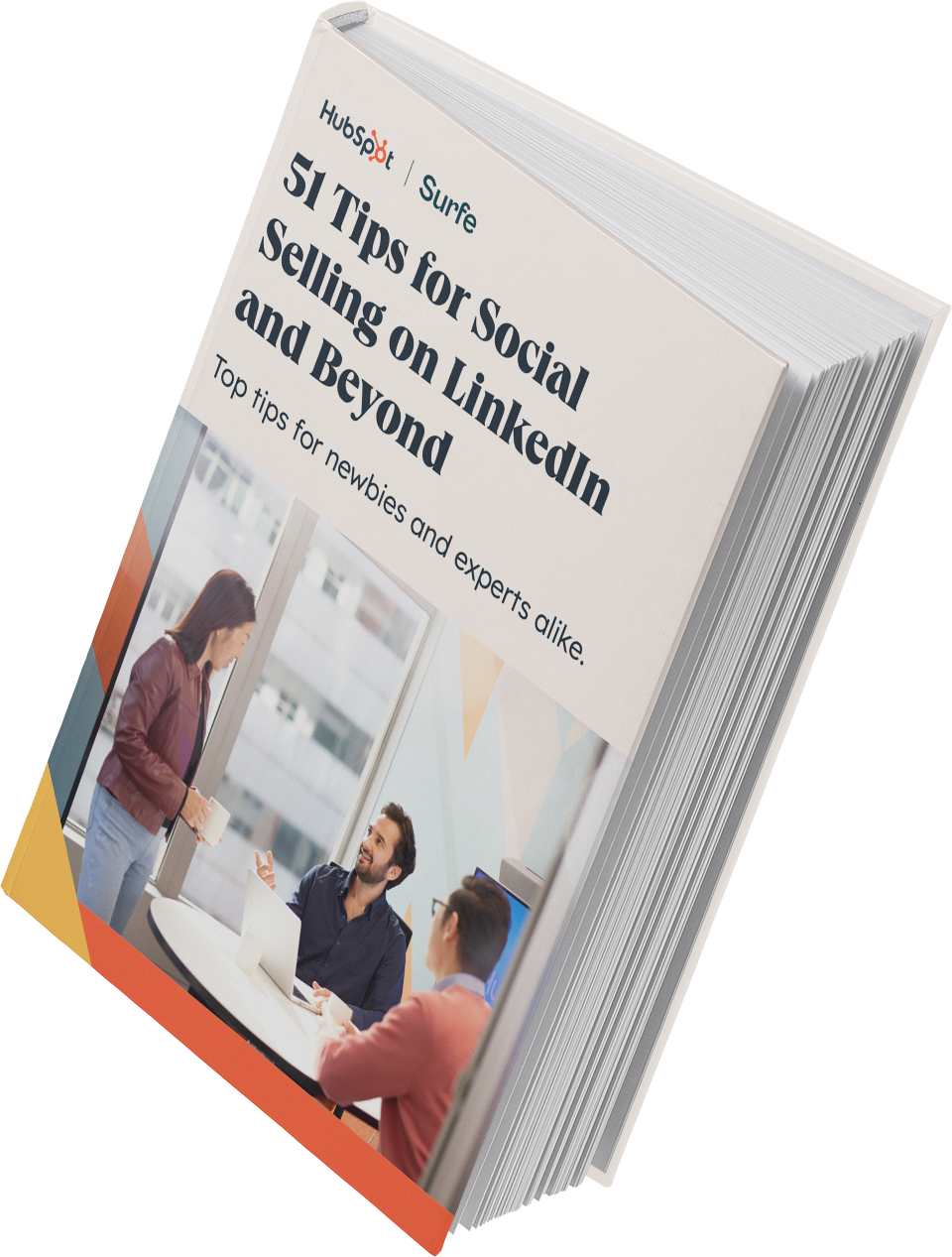
50+ for Social Selling on LinkedIn and Beyond
Use this guide to improve your social selling efforts and close more deals from platforms like...
-
-
TikTok
-
-
And more!
How to Think about LinkedIn
The above algorithms are an essential part of LinkedIn, but you will benefit from determining what you want from the platform before you dig into these tips and tricks.
A lot of comments are great, but it’s a vanity metric if what you really want is leads and sales. Or, maybe you’re using LinkedIn to find your next job, in which case you need to connect with hiring managers or recruitment agencies.
Whatever your LinkedIn goal, our top tips and tricks are categorized into four categories.
LinkedIn Hacks to Optimize Your Profile
1. Complete your entire profile.
Whenever you sign up for a platform where you want to stand out, your first goal should be a complete profile. This is a rule to live by in an online space.
By filling out your profile, you’re communicating to the algorithm that you care. Plus, information is data.
With the data you put on your profile, the LinkedIn algorithm can work in your favor — putting your profile in front of the people who will be most interested in seeing it.
So, carve out a couple of hours, grab a coffee, and work through the next eleven LinkedIn hacks. It’s never too late to optimize your profile, and I’m taking you through every step. Treat this next section like a checklist.
2. Think about keywords.
Your most valuable connections could be searching for someone just like you in the LinkedIn search bar. Optimize the content in your entire profile and increase the chances of appearing for relevant searches.
A quick search for “Virtual Assistant” returns profiles optimized for this search term.
From the screenshot, you can see the keywords are used:
- In the headline “freelance virtual assistant working with…”
- Within the experience section “Virtual Assistant at…”
We’ll cover headlines and experience sections in more detail shortly.
3. Personalize your URL.
If you start using LinkedIn properly, it will be a source of leads. For job searchers, it’ll become a place you’ll be eager for potential employers to see.
But first, you need to personalize your URL. Here’s how:
- Log in and head to your profile.
- Click “Edit public profile & URL.”
- Check the top right.
- Click the little pencil to edit the URL.
Keep the URL simple. Use your name if it's available.
How Personalizing My LinkedIn URL Helped Me
Using your name in your LinkedIn URL may help you rank on Google. As seen in the screenshot below, if someone searches for my name, they find my LinkedIn profile — and I couldn’t be happier about that.
This is largely to do with the personalized URL and a well-optimized profile.
LinkedIn is the primary source of my leads and clients, so it’s an excellent place for people to find me. Plus, a link to LinkedIn can also be found in my knowledge panel.
These small and very easy-to-implement tips and tricks make it easier to find me online.
4. Think about your headline.
Chima Mmeje has the best algorithm for writing LinkedIn headlines, one I followed when I started taking LinkedIn seriously. Mmeje says, “I have a simple formula for writing LinkedIn headlines: What you do + Who you do it for.”
Your heading is at the top of your profile and in every post or comment you leave, so you want it to be easy to read, short, and descriptive.
5. Use a great image and smile!
Your profile picture will factor into how other LinkedIn users perceive you. Photofeeler conducted a study that aims to deliver the formula for the perfect photo.
They found that your photo could impact perceived likability, influence, and even competency!
The study included 60,000 ratings on 800 profile pictures. Photofeeler reported that the most impactful characteristic was the right smile. A smile with teeth visible increases scores for competence and likability.
6. Optimize your banner.
Your banner must grab attention. Even better, it should clearly define your offering and give your viewer a reason to stay on your profile.
Jessica Lam Hill Young provides a great example. Her banner reinforces her brand, The Brand Creatives, and tells visitors what she does (content) and for whom (tech and SaaS companies).
The CTA in the banner directs visitors to the featured section, where you can book a call.
Another well-designed (and highly functional) LinkedIn banner belongs to Jasmin Alić. The banner offers a consistent brand experience for Hey Jay. The banner shares what Alić does and shows examples of his clients.
Alić uses his banner to help qualify leads. He tells profile viewers he’s available for 1:1 coaching and live training.
How I Use My Banner
My banner isn’t the beautifully designed masterpiece that I want it to be, but it is functional. I use my banner space to encourage a follow, “Follow for SEO tips and insights,” and share my most popular posts, the SEO Blasts.
7. Share your services.
You can add services you provide on LinkedIn. This is ideal for consultants, freelancers, and even agencies. Erin Balsa’s services include content marketing, content strategy, marketing consulting, copywriting, and editing.
Setting up services creates a LinkedIn service profile where people can find you and request your expertise.
Balsa has a website where she can capture leads, and she links to it from her profile. However, she doesn’t stop there. Her LinkedIn services page is another avenue for collecting leads and closing deals.
The services section signals to the algorithm that you’re in business and willing to serve fellow LinkedIn users. That may help LinkedIn put your content in front of the right people.
HubSpot uses the information you provide to us to contact you about our relevant content, products, and services. HubSpot will share the information you provide to us with the following partners, who will use your information for similar purposes: Surfe. You can unsubscribe from communications from HubSpot at any time. For more information, check out HubSpot's Privacy Policy. To unsubscribe from Surfe's communications, see Surfe's Privacy Policy.

50+ for Social Selling on LinkedIn and Beyond
Use this guide to improve your social selling efforts and close more deals from platforms like...
-
-
TikTok
-
-
And more!
My experience with the LinkedIn service page tip.
My service page has been set up for around one year. In that time, I’ve had
- Four genuine connections from potential clients
- Three meetings
- One client closed
It’s worth noting that I’ve not even filled this profile out to its full potential, and it’s resulted in revenue.
8. Provide contact details.
If you’re open to being contacted on LinkedIn, make sure to add your details.
Simply click the pencil in the top right of your profile and scroll down until you find them.
As you scroll, fill out every field possible. A complete profile shows the LinkedIn algorithm that you’re serious about your profile and the platform.
9. Shine in the experience section.
Your experience section is really important. If you want to be found in search, think logically about what people might search to find you. Include that information in your job titles and the description.
Add case studies with thumbnails and detailed descriptions to get even more out of this space. Share your roles and responsibilities in previous roles.
One great but underrated feature is adding media. You can add images for a quick glance. I add case studies in mine so visitors can see success without reading.
How Adding to My Experience Helped Me
The media added to my LinkedIn experience section is another way users can click through to my website. LinkedIn accounts for almost 22% of traffic to my website.
10. Take your time on the about section.
If someone is interested in reaching out to you, they will likely check out your About section. Writing this LinkedIn summary well is essential.
In their LinkedIn Profile Review Extravaganza, Nicholas Thickett and Morgan Smith share many LinkedIn hacks. In the video below, Smith and Thickett demonstrate how short the about preview is and why this matters.
They explain, “The preview is all you see until you click ‘see more,’ so one thing to keep in mind is you need to earn the click more with just that piece of text. The copy has to be engaging.”
In the screenshot above, Morgan Smith starts with a friendly “Hi, welcome to my LinkedIn profile” before sharing more about their shared podcast, what it’s about, and exactly when you might want to listen.
In the video below, Thickett and Smith continue to discuss the About section. They share the importance of starting with statements about yourself and ending with the history that gave you your knowledge and experience.
11. Put the most important items first.
The outline of your LinkedIn profile is in your control. You can move items within sections.
For many, the experience section is the most important. LinkedIn will order your experience by the latest first, but for those working on multiple projects, there may be one that you want to prioritize.
Here’s how to edit that section.
Step 1. Login, then scroll down to the experience section. Click the edit pencil at the top right.
Step 2. The experience section will open, and you’ll see the reorder arrows. Clicks those.
Step 3. A pop-up will open with your experience listed. You can reorder your experience as you like with a simple drag-and-drop.
12. Use the volunteer section.
Your volunteer section is your opportunity to share the ways you give back. You can use this section to share a bit of your personality and the causes that mean something to you.
Volunteer work related to your job also shows your genuine passion.
Watch the video below for more LinkedIn hacks on setting up the perfect profile.
LinkedIn Networking and Growth Tips
13. Send personalized invites.
On a free account, you can send 100 connection requests per week. If you’re connecting with other LinkedIn users, make your connection meaningful.
Don’t just hit “connect.” Follow up and add a note. Tell the person you’re connecting with why. Top LinkedIn creators or senior managers get hundreds of connections per day, and it’s overwhelming.
Make sure your connection stands out with a note.
Here’s a template to help this personalized invite LinkedIn hack work for you!
Hi [name],
I’ve been following you for [time] and loved your recent post on [topic].
I’d like to keep up to date with your posts. May we connect here?
Cite your true intentions. The above template works if you just want to keep updated, but you might want a different message, such as, “I’d love to meet for a coffee chat sometime (just for networking purposes!).
If you are connecting to try to sell something, you might as well be honest and send something like, “I believe my product/service might be of great use to you. Would you be open to a conversation?”
That said, I advise you to start with connection and networking first. Let the sell come naturally later.
Why I think personalized invites are important.
Active LinkedIn users and those in senior positions find the number of connections overwhelming. Like many, I receive hundreds of connections weekly.
However, connections are often used as a route to sell before the connection is ready.
It’s referred to as a “pitch slap,” and it’s generally frowned upon. For this reason, some are apprehensive about connecting with people who haven’t shared their intentions.
When I review my connections, I always prioritize those with a message. If it’s a good, soulful message, I’ll connect.
On the other side, if I‘m sending the connection request, I really want the person I’m connecting with to know this is genuine, and I want to share why I want to join their network.
14. Reach out to your connections.
Social media is here to be social — yes, even LinkedIn.
Ben Goodey has the courage to contact industry experts. He invites his connections to share SEO case studies on his podcast.
“Almost all my podcast guests come from LinkedIn. I mostly see really cool stories posted and then DM people about that specifically,” Goodey says. “Almost everyone is really keen, and I think that’s a combination of being connected for a while or reaching out about something specific.”
1. Attend and Run Audio Events
Audio events are a new feature for LinkedIn; a broader recommendation would be to use any new features released by LinkedIn. A general rule for social media is to make use of all features.
The more features you use, the more the social media app can test its success, so you may see a boost in engagements or impressions.
Kenda Noel from Boomtag Media ran audio events on LinkedIn. Noel credits the events for networking. Listeners can ‘take the stage’ upon invite and ask the hosts questions.
Noel found the events easy to host; there was no need for professional equipment, and it was a great way to engage with followers.
Finally, Noel credits the audio event with a growing network; you may reach the audience of your guests and participants. The good news is you don’t have to host an event to benefit; just attend existing events and get involved.
There are some downsides. Noel tells me there’s no recording available, so repurposing content isn’t possible. However, Noel is taking everything she learned by running audio events and transferring this knowledge to a podcast.
My experience with audio events
I joined Noel for her first event. We’d been connected for some time. I’d echo Noel’s thoughts that it is a great way to network. I feel like our connection is stronger now.
At one time, we had around 45 guests listening or participating, and I got to ‘meet’ more of my followers and engage with them through live-voiced questions and answers.
I felt more personal than engaging in the comment section of my posts.
15. Comment, comment, comment.
LinkedIn loves comments. This is clear from the notification system, which encourages users to be active commenters.
As expected, LinkedIn will notify you when someone replies to your comment or pops a comment on your post. However, LinkedIn takes comment notifications one step further.
The platform will notify you if someone comments on a post you simply reacted to. LinkedIn wants to bring you back to the discussion on the content you showed an interest in.
Jasmin Alić is a LinkedIn guru with over 200,000 followers. He credits a good comment strategy with
- Authority and brand influence.
- Consistent visibility and hires.
- Growing a network.

My Experience With This Commenting Tip
This is anecdotal, but I know I’m not the only one who takes commenting seriously on LinkedIn. I find that when I comment regularly and meaningfully on other creators’ LinkedIn posts, my posts get a little boost in the algorithm.
If I have a very busy week and my commenting hasn’t been plentiful, my posts don’t perform. My theory is that the algorithm rewards active LinkedIn users.
This is just one benefit of commenting. There are others, such as post inspiration. I often turn a comment into a full LinkedIn post, and some of these posts are my best-performing posts!
Top tip for repurposing comments: Follow good etiquette. If you’ve been inspired by someone else’s LinkedIn post, credit them.
16. Look at interesting views.
From your LinkedIn feed page, you can click to see who’s viewed your profile. You can click through and filter viewers to find interesting ones. Your interesting viewers may include people who can further your career.
If they’ve expressed interest in you by viewing your profile, there’s every chance they’d be receptive to a connection request or message.
17. Be yourself.
LinkedIn is often mistaken for a stuffy business platform with no personality, but this isn’t true. While you do need to bring a level of professionalism and politeness to LinkedIn, don’t be afraid to be yourself, especially when engaging with others.
People don’t hire or connect with people they don’t like. So, don’t be afraid to let your personality shine through in your connection messages, your posts, and the comment section.
Dave Harland is a great example of a creator who knows how to be himself. His posts are witty. He’s amassed over 90,000 followers, and I have no doubt Harland has plenty of leads in his inbox.
His comedic posts are a testament to his skill as a writer. He strikes a balance between entertainment and driving engaged users to his newsletter.
18. Find your voice and post.
If you want people to find you on LinkedIn, you must post. Posting regularly is a sign to LinkedIn that you’re active and want people to see your posts.
Haris Husejnovic, CEO at Robinize, uses LinkedIn to find recruits for his business. He advises that those seeking recruitment should have “at least some activity, if not posting, then liking and following other creators.”
Husejnovic looks for signs of activity in posts and banner images. If someone hasn’t replaced their banner, it looks like they’re inactive on the profile.
It’s common to feel apprehensive about posting. You might worry about who’s reading or how many people aren’t reading. Practice makes perfect. You’ll find your voice, and posting will become natural.
Indiana Julian now has a following of over 3,000. She plucked up the courage to post to LinkedIn and shared some of the benefits in a post on the platform.
“I only started posting here around eight weeks ago, sticking to around two posts per week … through this platform, I’ve been able to expand my network globally to like-minded people, share ideas and learn from other young business owners, gain confidence and kick the imposter syndrome (most of the time!)...gaining awesome clients along the way,” Julian says.
HubSpot uses the information you provide to us to contact you about our relevant content, products, and services. HubSpot will share the information you provide to us with the following partners, who will use your information for similar purposes: Surfe. You can unsubscribe from communications from HubSpot at any time. For more information, check out HubSpot's Privacy Policy. To unsubscribe from Surfe's communications, see Surfe's Privacy Policy.

50+ for Social Selling on LinkedIn and Beyond
Use this guide to improve your social selling efforts and close more deals from platforms like...
-
-
TikTok
-
-
And more!
LinkedIn Posting Hacks
You may be surprised to hear but posting and using LinkedIn is all about having fun! If LinkedIn becomes a chore, your personality might not shine through. Find a way to post to keep you motivated and your audience engaged.
19. Create carousels.
Sam Browne from HARO SEO grew rapidly on LinkedIn and became a top 200 creator. Browne credits some of his success to carousel posts. One carousel earned him an impressive 12,000 followers in 24 hours.
On carousels, Browne says, “Carousels allow you to break up a long, unappealing text post and turn it into something interactive and fun.”
Browne notes that he posts once or twice a week rather than five or more times weekly. That’s because he spends hours on each post, making them interesting, insightful, and inspiring.
Browne says, “By doing this over and over again, I’ve been able to grow from a few hundred followers at the start of 2022 to over 45,000 today.”
Below is the post that helped Sam Browne grow. See what you can learn and how to use carousels to grow on LinkedIn.
My Experience Using Carousels
I’ve posted 36 carousels to my LinkedIn in around two years. Some of those 36 carousels are duplicates. The same document was posted twice, with a reasonable amount of time in between.
Sometimes, I tweak the second post so they’re slightly better than the last.
I found that 40% of my most engaged posts are carousels. They’re worth the extra effort to create, and you can repurpose them. I have them available for download on my website, and I use them as guides for clients.
20. Make use of video.
Megan Thudium is a LinkedIn consultant for sustainable brands. Video is a major part of her LinkedIn strategy.
“Video is still relevant. Video posts receive one of the highest engagement rates on LinkedIn, next to carousel posts,” she says. “Video remains a top content type to drive brand awareness and conversions.”
If you want people to find your posts, try video. Every engagement helps push your content out to the network of those who react, repost, or comment.
21. Post at the same time every day.
I think regular posting at the same time, on consistent days, is the best tactic, but there are differing opinions.
Both Indiana Julian and Sam Browne, aforementioned, posted 1-2 times per week and reported great success on the platform.
HubSpot gathered data from three sources and found the best posting times for LinkedIn were
- Between 10:00 a.m. and 12:00 p.m. on Tuesday, Thursday, and Wednesday.
- Between 9:00 a.m. and 5:00 p.m. on weekdays.
While the data isn’t conclusive, HubSpot also found that the lowest-performing days are Sundays, Saturdays, and Mondays.
How I Use the Posting Time Hack to My Benefit.
I’ve found that posting between 5:00 a.m. and 7:00 p.m. every weekday is most effective for my audience. I’ve also had content perform better on weekends than on weekdays.
For me, the bottom line is this: It’s more important that you post when you are most inspired and ready to put great content out into the world of LinkedIn.
22. Create a posting process.
If you’re committing to LinkedIn, help yourself and create a process. I share my tried-and-tested process in the post below.
Why I Think a Posting Process Works
Regularly posting to any social media is hard work, especially if you’re putting out high-quality content, as you should be.
A posting process helped me stay consistent and allowed me to do what I love (writing the posts and engaging) instead of the things I don’t (uploading the posts).
23. Pin featured posts.
You can pin posts to the featured section of your profile. All you need to do is follow these steps:
- Post something.
- View the post, then click the three dots in the top right corner.
- In the menu, click “Feature on top of profile.”
You can use your featured section to promote your services, share your best posts, or introduce yourself.
Brianna Doe makes great use of this space. She shares her curated job board, a link to her website, and a top-performing post. The featured section is promotional for Brianna Doe and useful for her followers.
How Pinning Posts in the Featured Section Works for Me
In my featured section are pinned posts that link to websites where you can download my free guides. I never advertise these on LinkedIn, yet I get at least a daily download per day.
24. Use images and GIFs in posts.
It’s no secret that media such as video, images, and GIFs all increase post engagement. LinkedIn says posts with images receive 2x the engagement than those without.
Unlike other platforms, LinkedIn doesn’t make adding GIFs easy. You can’t insert them from the post editor.
Here’s how you add a GIF.
Step 1. Fetch a link from a resource like Giphy.
Step 2. Paste the link into your post. The media item will show up in your LinkedIn post.
Pro tip: Once the GIF is displayed in the post, you can remove the link, and the GIF will remain in place.
25. Tell your story.
If you want to reach people in a way that matters, you’ll want to share stories. Your connections and followers want to hear your stories in a way that is relatable to them.
Ash Rathod is a brand story strategist at Digital Focus. As you might expect, Rathod advocates strongly for the power of storytelling on LinkedIn.
In his post below, Rathod credits great storytelling with his success on LinkedIn.
He advises that through storytelling, you “make the reader believe they’re reading their own story. The details don’t have to be of their life. But the pain points and promise of transformation do.”
How I Use Storytelling
I tell stories in my LinkedIn posts and am happy to get fairly personal in them. What you share is up to you. A good tip is to relate your personal stories back to business.
That’s what I generally do, but my most personal story was about my wedding, and that post is my third most engaged post in the last 365 days, with 705 engagements.
Another post where I share my freelancing journey has 549 engagements and is the fifth most engaged post.
26. Add a bio to the bottom of a post.
You never know when a LinkedIn post might appear on a stranger’s feed or go viral.
One way to quickly share what you do with an unknown audience is to add a bio — almost like an email signature — at the bottom of your posts.
You can share what you do and what you share on LinkedIn. It might encourage someone to view your profile, follow, or connect.
Here’s an example from Megan Thudium.
27. Consider creating your own hashtag.
If posting a content series, you can add a hashtag that groups content.
Before you choose your hashtag, search for it in the LinkedIn search bar. If no one else is using it, claim it as your own! Your hashtag makes your most valuable content searchable for your followers.
Kristina Azarenko uses #seokristina. A quick search on this hashtag will help you find her content neatly grouped within the search.
My Experience Creating My Own Hashtag
I created my hashtag #ZoeSEO to compile my “SEO Blasts.” These posts are SEO tasks that my audience can do now. I share actionable advice and step-by-step guides.
SEO Blasts are often my most engaged posts, so I know they're helpful. With the hashtag, people can read more of them if they want to.
28. Be consistent.
Consistency is really important on any social media platform. It signals to the algorithm that you’re taking the platform seriously.
Consistency is also important for building a following and nurturing relationships. If people know you’re on LinkedIn, they’ll look out for you there. They’ll get used to your golden posts and search for you to keep up with what you’ve got to say.
29. Avoid overusing AI.
If you hang out on LinkedIn regularly, you won’t be surprised to hear that AI is not always used brilliantly there.
AI tools that rewrite comments and the use of ChatGPT aren’t helping genuine engagements, and creators are tired of replying to AI-generated responses.
Only 5% of social media marketers surveyed by HubSpot believe LinkedIn will have the most promising generative AI features this year.
I’m not saying never use AI, but make sure you add your unique experience and edit the content so it reads like you have written it.
How I Use AI on LinkedIn
I write my LinkedIn content in bulk. Toward the end of the month, I will write enough posts to cover Monday through Friday next month. I often turn to AI tools to help me develop ideas and write the first draft.
It saves time and helps the ideation process.
I refuse to use AI to generate comments. This removes the social aspect and genuine connection.
LinkedIn Tips for Inbound Sales and Marketing
30. Develop your writing skills.
Great writing stops the scroll and encourages engagement. The more engagements, the more your content gets pushed to the right people. If you want to do well on LinkedIn, develop your writing skills.
Doug Kennedy is a top copywriting voice on LinkedIn. He believes he’s found the perfect 4-step formula to craft an engaging LinkedIn post.
The steps:
- Get attention with a hook.
- Provide value.
- End with a memorable line.
- Include a clear call to action.
How I Develop My Writing Skills
If I post something that results in strong engagement, I take that post, refine it, and post it again later. You’ll be amazed how a little tweak can go a long way.
One post received 2,559 engagements. I was very proud of it! I took the same post, tweaked it, and posted it again, maybe a year later. The second refined post received 200,105 engagements.
The reason? I’d understood what performed well, then improved my writing to attract more valuable actions.
If you can write well, you can land on more feeds and put your brand in front of the right audience. Think of it as a brand visibility campaign. Level it up with value.
31. Provide value.
Kennedy, referenced above, shares the importance of providing value in his four-step formula.
Every single lead I’ve obtained from LinkedIn has been inbound. I’ve not messaged a single lead nor have I paid for one. I simply show up on LinkedIn every day and provide value.
A good tip for providing value is to write the content you wish you had when you started or the content you wish you had months or years ago.
A lot of my content is educational and told with examples and actionable next steps so my audience can try SEO tactics for themselves.
32. Collaborate on articles.
LinkedIn’s article collaborations provide a space for you to
- Share expertise.
- Show up in Google as a collaborative author on their ranking posts.
- Earn a nice “top voice” badge.
The Top Voice badges takes a proud position under your profile picture. Kennedy has the Top Copywriting Voice.
Potential leads may see the badge as a vote of confidence, and connections will see his collaborations as he publishes them; this equals more brand visibility.
My Experience With LinkedIn’s Collaborative Articles
For a time, I had the “Top SEO Voice” on my profile. Aside from the benefits listed above, I found the collaborative articles helpful for content and post ideation.
Comments left on the articles could be fleshed out into bigger ideas and posts that my audience loved.
HubSpot uses the information you provide to us to contact you about our relevant content, products, and services. HubSpot will share the information you provide to us with the following partners, who will use your information for similar purposes: Surfe. You can unsubscribe from communications from HubSpot at any time. For more information, check out HubSpot's Privacy Policy. To unsubscribe from Surfe's communications, see Surfe's Privacy Policy.

50+ for Social Selling on LinkedIn and Beyond
Use this guide to improve your social selling efforts and close more deals from platforms like...
-
-
TikTok
-
-
And more!
LinkedIn Hacks for Job Seekers
Job seekers want potential employers and recruiters to notice them. You can do this by optimizing your profile and connecting and chatting with the right people. More on how to achieve this below.
33. Be polite to recruiters: connect.
Recruiters use LinkedIn to find talent for their clients. If you’re actively looking for a job, chat with recruiters. Don’t be afraid to approach them first and be responsive to their replies.
34. Get certified.
Natasha Woodford, director of talent at Clockwork Talent, uses job seekers’ LinkedIn profiles to find recruits for her clients.
“Be sure to add industry certifications and specific skill sets that you’re accomplished in,” Woodford says. “These, along with ensuring your professional experience is up to date, will make your profile more attractive to both hiring managers and recruiters. It also makes you easier to find!”
Think of your LinkedIn profile as a hub of all of your relevant professional qualifications. Any information you can add to bolster your expertise and authority should be featured on your LinkedIn profile.
Certifications are a sign of someone who is qualified for the job at hand, as well as someone who genuinely loves what they do. Taking the initiative to take a qualification shows genuine care and passion for your job.
35. Have a public profile.
You can edit the privacy of your LinkedIn profile in the settings. If you’re hoping to find a job via LinkedIn, make sure your profile is public. Recruiters will need a searchable profile to find you.
36. Be professional.
LinkedIn is ultimately a professional network. Mike Hill, a digital recruitment consultant at Cloud Source Recruitment, uses LinkedIn to find candidates.
When looking for candidates, he looks for a “full profile with insight into current role and previous roles as a minimum.”
Professionalism is also important.
“Also, have a photo, preferably one which is not holding a beer from your summer holiday or skiing from your winter one,” Hill says. “Any insight/detail on key achievements is also powerful. Check spelling mistakes, especially in job titles (i.e., manger instead of manager), which can knock you out of searches.”
37. Use keywords from job postings.
Hill says, “Avoid terms like Ninja, Guru, etc., and think about keywords that recruiters are likely to use that reflect your skill set and make you easier to find.”
Novelty job titles can be fun, but if recruitment is your goal, it’s better to avoid them.
38. Use the “Open to Work” frame.
On the Open to Work frame, Hill says, “It has its uses and helps candidates increase in searches on LinkedIn Recruiter. Frustratingly, many candidates don’t update their status when they find a new role and cease to be on the market, which reduces its effectiveness.”
It’s worth adding the Open to Work frame to rank higher in searches, but keeping our profiles up-to-date would make the recruitment side of LinkedIn easier for everyone.
39. Ask for recommendations.
Recommendations are incredibly powerful for all job seekers. If you can get third-party credibility onto your LinkedIn, do it!
A former manager or colleague writing great things about you is more likely to persuade a potential employer to give you a chance than you writing great things about yourself.
A great example of recommendations done right is Kayla Ihrig, who has up-to-date testimonials from impressive clients.
As a content creator and digital nomad at Writing From Nowhere, recommendations from managing editors at well-known brands like GoDaddy can only help Ihrig’s chances of securing another opportunity like it.
40. Use and share your LinkedIn profile.
If you’ve spent time creating a perfect LinkedIn profile that you’re proud to share with the world, make sure you’re getting it out there.
Your profile will pick up natural traction within the LinkedIn platform, but to get the most out of it, you can drive your own traffic there.
Add your LinkedIn profile to your CV and update your email signature. When you submit applications for jobs, the hiring manager might take a look.
You might be able to use the “interesting views” hack from earlier to see if you’re getting any visits! It’ll give you an indicator of how engaged your potential recruiters are.
Don’t give up on these LinkedIn tips, and you will succeed!
There’s a reason why 89% of social media marketers are continuing (50%) or increasing (39%) their investment in LinkedIn marketing efforts: LinkedIn works.
As a creator, you need to find out how you can work with the algorithm and maintain your authenticity on the platform in a way that drives your LinkedIn objectives.
So, decide what you want from LinkedIn, then implement every tip possible. I promise you, it works! This is exactly what I did in two years. I found an article just like this and implemented everything it told me to.
Two years later, I have 27,000 connections, and incredible network of high-value clients, and more leads than I can serve.
This post originally appeared on HubSpot’s Sales Blog. To read more content like this, subscribe to Sales.
Editor's note: This post was originally published in May 2015 and has been updated for comprehensiveness.

